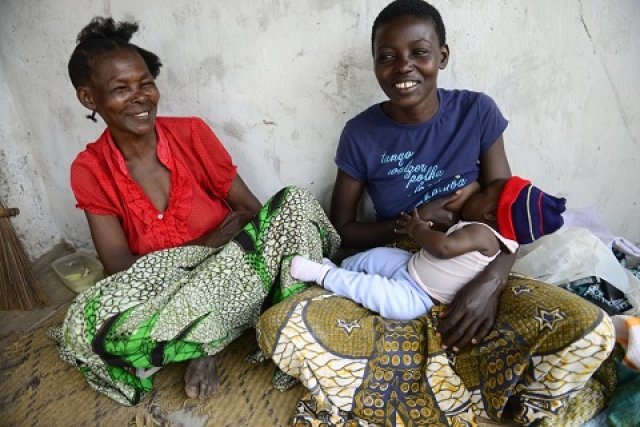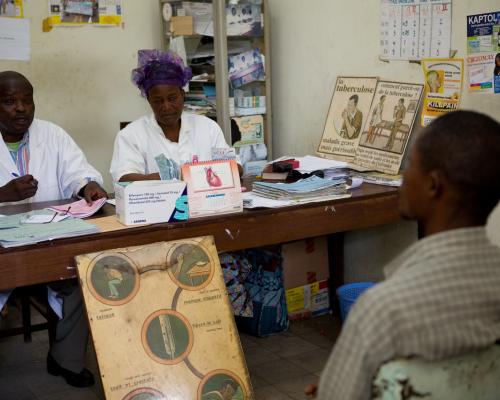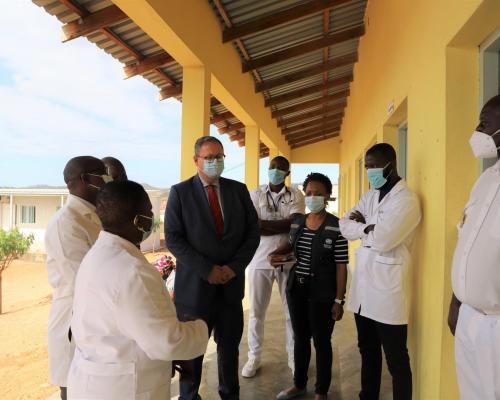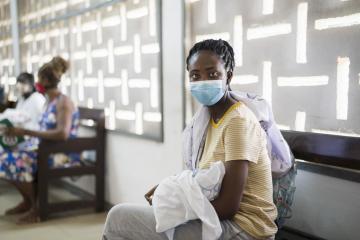Factsheet
Key facts
- Every year nearly 45% of all under 5 child deaths are among newborn infants, babies in their first 28 days of life or the neonatal period.
- Three quarters of all newborn deaths occur in the first week of life.
- In developing countries nearly half of all mothers and newborns do not receive skilled care during and immediately after birth.
- Up to two thirds of newborn deaths can be prevented if known, effective health measures are provided at birth and during the first week of life.
The vast majority of newborn deaths take place in developing countries where access to health care is low. Most of these newborns die at home, without skilled care that could greatly increase their chances for survival.
Skilled health care during pregnancy, childbirth and in the postnatal (immediately following birth) period prevents complications for mother and newborn, and allows for early detection and management of problems. In addition, WHO and UNICEF now recommend home visits by a skilled health worker during a baby's first week of life to improve newborn survival. Newborns in special circumstances, such as low-birth-weight babies, babies born to HIV-positive mothers, or sick babies, require additional care and should be referred to a hospital.
Newborn, or neonatal, deaths account for 45% of all deaths among children under 5. The majority of all neonatal deaths (75%) occur during the first week of life, and between 25% to 45% occur within the first 24 hours.
The main causes of newborn deaths are prematurity and low-birth-weight, infections, asphyxia (lack of oxygen at birth) and birth trauma. These causes account for nearly 80% of deaths in this age group.
Up to two thirds of newborn deaths could be prevented if skilled health workers perform effective health measures at birth and during the first week of life.
Home visits by a skilled health worker immediately after birth is a health strategy that can increase newborn survival rates. The strategy has shown positive results in high mortality settings by reducing newborn deaths and improving key newborn care practices. While home births are very common in developing countries, only 13% of women in these countries receive postnatal care in the first 24 hours. Many mothers who give birth in health facilities cannot return for postnatal care because of financial, social or other barriers. The first days of life are the most critical for newborn survival.
Home care visits should occur on days 1 and 3 of a newborn's life, and if possible, a third visit should take place before the end of the first week of life (day 7).
During home visits, skilled health workers should perform the following measures.
- promote and support early (within the first hour after birth) and exclusive breastfeeding;
- help to keep the newborn warm (promoting skin-to-skin contact between mother and infant);
- promote hygienic umbilical cord and skin care;
- assess the baby for signs of serious health problems, and advise families to seek prompt medical care if necessary (danger signs include feeding problems, or if the newborn has reduced activity, difficult breathing, a fever, fits or convulsions, or feels cold);
- encourage birth registration and timely vaccination according to national schedules;
- identify and support newborns that need additional care (e.g. those that are low-birth-weight, sick or have an HIV-infected mother); and
- if feasible, provide home treatment for local infections and some feeding problems.
Some newborns require additional attention and care during home visits to minimize their health risks.
Low-birth-weight babies:
- increased attention to keeping the newborn warm, including skin-to-skin care immediately following birth for at least an hour, unless there are medically justifiable reasons for delayed contact with the mother;
- assistance with initiation of breastfeeding within the first hour after birth, such as helping the mother express breast milk for feeding the baby from a cup if necessary. (If a baby is unable to accept feeding from a cup, the newborn should be referred to a hospital);
- extra attention to hygiene, especially hand washing;
- extra attention to health danger signs and the need for care; and
- additional support for breastfeeding and monitoring growth.
Sick newborns:
- the families of newborns with severe illness should be helped in locating a hospital or facility to care for the baby; and
- newborns should be treated for infections (e.g. with antibiotic injections) by a nurse, doctor or skilled health worker.
Newborns of HIV-infected mothers:
- preventive antiretroviral treatment (ART) for mothers and newborns to prevent opportunistic infections;
- HIV testing and care for exposed infants; and
- counselling and support to mothers for infant feeding. (Community health workers should be aware of the specialized issues around infant feeding. Many HIV-infected newborns are born prematurely and are more susceptible to infections.)
WHO and its partners agree that a core principle underlying maternal, newborn and child health efforts is lifelong access to health care: a continuum of care for the mother starting from long before pregnancy (during childhood and adolescence) through pregnancy and childbirth. The continuum begins again with adequate newborn care for the new life. As appropriate, care can be delivered in the home and community, as well as health clinics and hospitals.
For more information contact:
WHO Media centre
E-mail: mediainquiries@who.int

Brazzaville, 17 December 2014 - According to a new WHO report, one third of all neonatal deaths occur in the African Region. Approximately three quarters of these deaths occur during the first week of life and almost half within the first 24 hours.
The first 28 days of life, called the neonatal period, is a very risky period for babies. For every newborn baby that dies, another 20 will face illness or disability from conditions such as birth injury, infection, the inability to breathe normally after birth, neonatal tetanus, congenital anomalies, and the complications of premature birth.
Too many babies are also being born to mothers who have not had adequate nutrition and antenatal care during pregnancy and who were not given skilled care during the birthing process. These mothers are at the greatest risk of dying during or after delivery – leaving newborns at an even greater risk of dying from inadequate care and suboptimal feeding practices.
According to statistics, quality care with simple, accessible, cost–effective interventions can prevent up to two thirds of all neonatal deaths. One method that has worked to reduce neonatal deaths in the African Region is kangaroo mother care (KMC). KMC is caring for preterm infants by carrying the baby skin-to-skin, usually by the mother.
“Essential interventions that contribute towards improving the survival of newborn babies include skilled care during the time of delivery where resuscitation can be performed, if required, exclusive breastfeeding, kangaroo mother care for preterm and low-birth weight babies, and the prevention and treatment of infections,” said Dr Tigest Ketsela Mengestu, Director of the Health Promotion Cluster of the World Health Organization Regional Office for Africa.
Using KMC to care for stable preterm babies has been especially beneficial in resource-poor settings. It has been shown to reduce mortality among preterm babies (< 2000 g) in hospitals by 51% if started in the first week of life compared with incubator care.
Malawi is a prime example of where KMC has been successfully used in health care settings. It’s been reported that deaths of newborn babies have been reduced from 40 deaths per 1000 live births in 2000 to 24 deaths per 1000 live births in 2012. Malawi is one of the few countries in the Region that has already achieved its 2015 Millennium Development Goal 4 targets.
Another key to success in an African context is boosting community involvement. Many people do not go to a health care facility when they need care. Improving the quality of care at health facilities alone would not reduce neonatal and child mortality rates significantly. One way to improve this is to deliver more services through community providers.
Community health workers (CHWs) are examples of community providers. They are trained to visit pregnant women at home to educate mothers about nutrition, breastfeeding, prevention of mother-to-child transmission (PMTCT) of HIV, and on-going care requirements.
CHWs also play an important role in saving the lives of newborns through home visits during the postnatal period. This allows them to review the health of the newborn and the mother, and to connect them to appropriate health care services.
There is an urgent and on-going need for newborn health to be placed high on the global political agenda. Strong political commitments, the allocation of adequate resources, and the scaling up of a few known cost-effective interventions will save many newborn lives.
_________________________________________________
For additional information:
Technical contact:
- Dr Assumpta Muriithi
Tel: +472 413 9212
Email: muriithia@who.int
Media contacts:
- Cory Couillard
Tel: +472 413 9995
E-mail: couillardc@who.int - Collins Boakye-Agyemang
Tel: + 472 413 9420
E-mail: boakyeagyemangc@who.int

Brazzaville, 12 January 2015 – Every day an estimated 8000 children die in sub-Saharan Africa from easily preventable or treatable illnesses. Breastfeeding is one of the best ways to provide newborns, infants and young children with the nutrients that they need while protecting them against conditions such as pneumonia, diarrhoea, and measles.
The World Health Organization (WHO) recommends exclusive breastfeeding that starts within one hour after birth and lasts until a baby is six months old. Continued breastfeeding and appropriate complementary foods should be made available for up to two years of age and beyond.
In mid-2013,WHO issued new guidelines for breastfeeding and the prevention of mother-to-child transmission (PMTCT) of HIV. These recommendations were intended for use in resource-poor settings in low-and middle-income countries.
A mother can pass the HIV infection during pregnancy, delivery and through breastfeeding. In some African counties, it is estimated that 20 to 30% of pregnant women are infected with HIV and transmission rates from mother-to-child range from 25 to 40%. Antiretroviral therapy (ART) can significantly reduce the risk of transmission.
“One of the new recommendations for PMTCT is to promote the use of ART in all pregnant and breastfeeding women. These new recommendations also include providing ART - irrespective of one’s CD4 count - to all children with HIV under 5 years of age, all pregnant, and all breastfeeding women with HIV,” said Dr Tigest Ketsela Mengestu, Director of the Health Promotion Cluster of the World Health Organization Regional Office for Africa.
To encourage people to do this and to make testing services more widely available, WHO (HQ, Regional and country-level) have worked together with partner organizations to adapt, disseminate and implement these new guidelines in countries.
At least 90% of people living with HIV/AIDS across the African Region do not know that they are HIV positive, and HIV tests are often expensive and not always available to pregnant or breastfeeding mothers and children. More women and children are being encouraged to come forward to be tested for HIV as services become more readily available.
In sub-Saharan Africa, health systems are fragile and staffing is often grossly inadequate to meet rising health needs. Community health workers (CHWs) often play an important role in educating mothers about nutrition, breastfeeding, PMTCT of HIV, and on-going care requirements.
CHWs also save the lives of newborns through home visits during the postnatal period. This allows them to review the health of the newborn and the mother, and to connect them to appropriate health care services, wherever there is a need.
While progress has been made in promoting breastfeeding in the African Region, significant challenges remain. Africa is a vast continent containing extremes of poverty and wealth. Undernutrition is still the most important underlying factor causing high infant and child mortality in the Region.
In order to improve infant and child health and kick off the post-2015 development agenda, governments in the Region need to expand the use of safe breastfeeding. In 2012, the World Health Assembly, the decision-making body of WHO set the target of increasing the percentage of exclusive breastfeeding from 37% to at least 50% by 2025.
______________________________________
For more information, please contact:
• Technical contacts:
Dr Adelheid Werimo Onyango
Tel: +472 413 9743
Email: onyangoa@who.int
Dr Phanuel Habimana
Tel: +472 413 9407
Email: habimanap@who.int
• Media contacts:
Cory Couillard
Tel: + 472 413 9995
E-mail: couillardc@who.int
Collins Boakye-Agyemang
Tel: + 472 413 9420
E-mail: boakyeagyemangc@who.int




